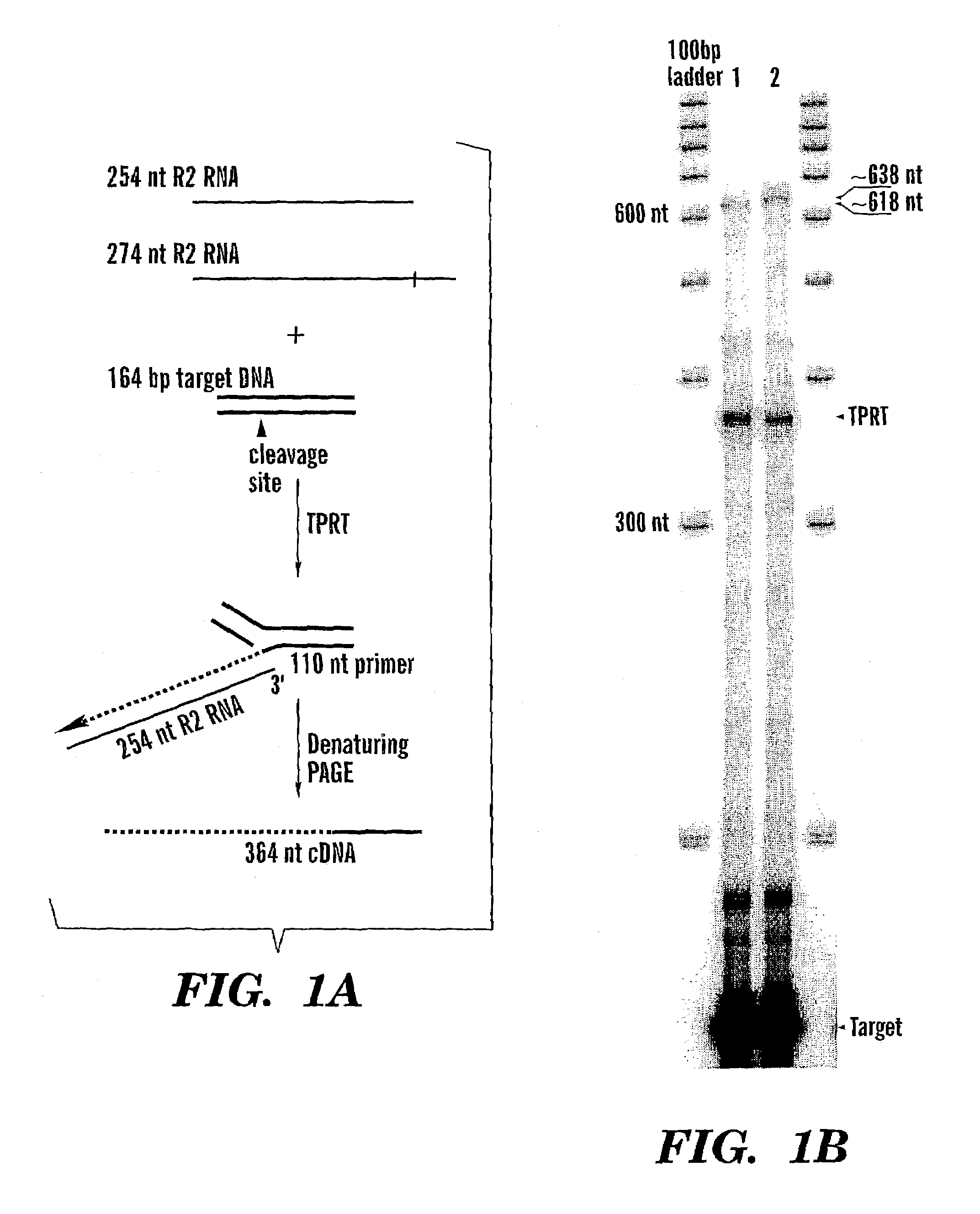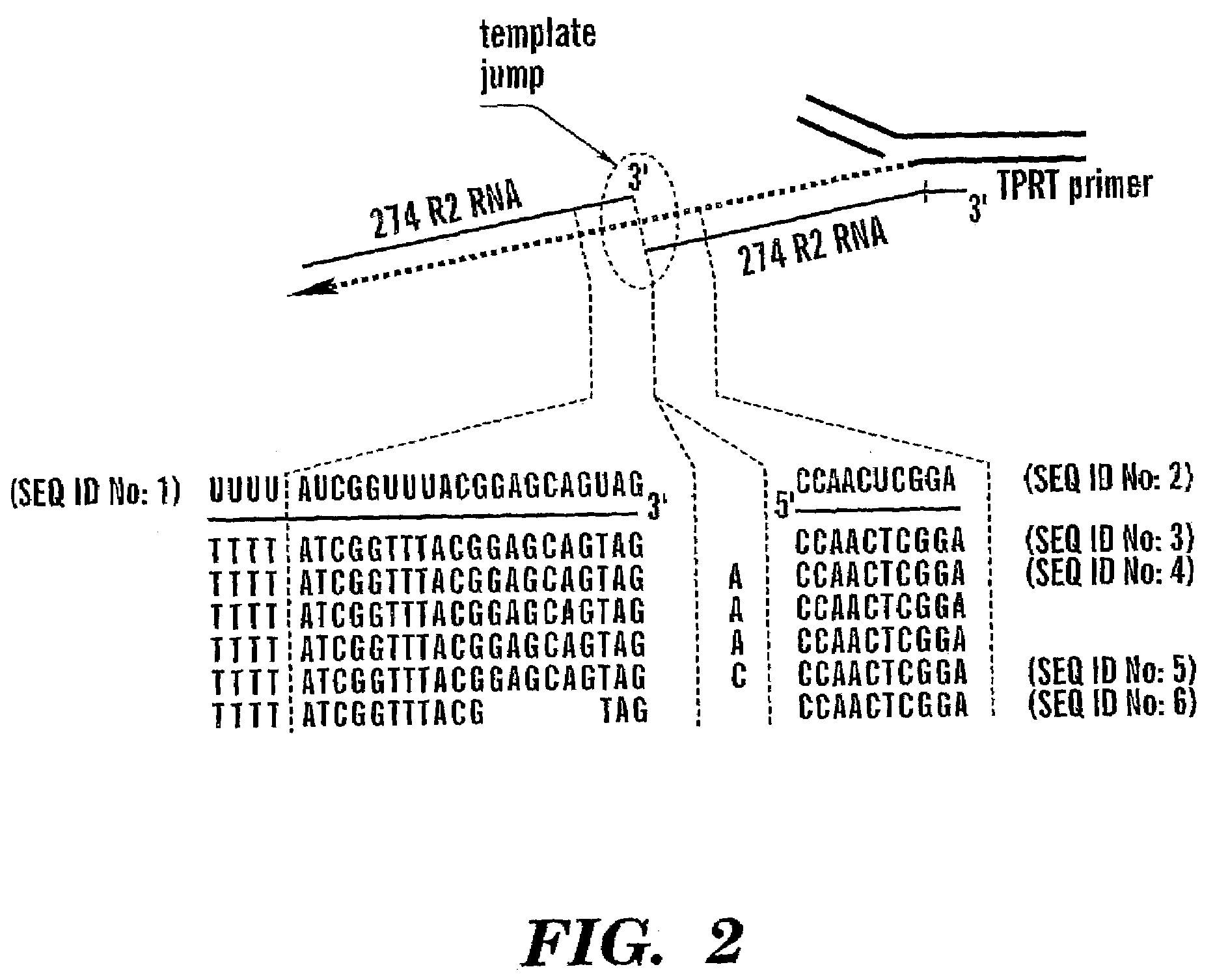Method of performing reverse transcription reaction using reverse transcriptase encoded by non-LTR retrotransposable element
a reverse transcriptase and retrotransposable element technology, applied in the direction of transferases, peptides, peptide sources, etc., can solve the problems of low processivity of enzymes and inability of enzymes to transcribe through the region of rna secondary structure, and achieve no deleterious effect, and enhance reverse transcriptase activity
- Summary
- Abstract
- Description
- Claims
- Application Information
AI Technical Summary
Problems solved by technology
Method used
Image
Examples
example 1
Recombinant Expression of the Bombyx mori R2 Protein
[0088]The expression construct, pR260, was derived from construct pR250 (Xiong & Eickbush, Cell 55:235–246 (1988), which is hereby incorporated by reference in its entirety). A 3.5 kb Smal fragment of pR250 from 18 bp upstream of the first methionine codon to the 3′ end untranslated region was subcloned into pUC18 in-frame with the lacZ gene. E Coli strain JM109 / pR260 was grown at 37° C. in LB broth until an OD595=0.5–0.6. Isopropylthio-β-galactoside (IPTG) was then added to a final concentration of 0.2 mM and the cultures were further incubated for 1 hour. Cells are harvested by centrifugation, washed in cold 50 mM Tris-HCl, pH 8.0, and collected by centrifugation. The following procedure is described for a 1.5 liters of cells but can be scaled to larger or smaller culture volumes. All procedures are conducted at 0–4° C. The cell pellets are resuspended in 6.8 ml buffer A (0.1 mM Tris-HCl pH7.5, 5 mM EDTA, 50% glycerol) and incuba...
example 2
RNA Template Jumping After Target-Primed Reverse Transcription
[0090]The signature step of the TPRT reaction is the use of the 3′ hydroxyl group released by first-strand cleavage of the DNA target site as primer for cDNA synthesis. This cleavage / reverse transcription reaction can be studied in vitro using purified components as shown in FIG. 1. The substrate in the assay is a uniformly P32 labeled DNA fragment containing the 28S rRNA gene insertion site. The R2 cleavage site on this substrate is positioned such that a 110 nt fragment is used as the primer. The RNA templates added to the reaction contain the minimum sequences needed to initiate the TPRT reaction: the 3′ untranslated region of the R2 element. The R2 RNA templates are either 254 nt in length, if the RNA ends at the precise 3′ junction of the R2 element, or 274 nt in length, if the RNA extends 20 nt into the downstream 28S gene sequences.
[0091]Denaturing polyacrylamide gel electrophoresis of typical TPRT reactions are sh...
example 3
RNA Priming of the Reverse Transcription Reaction
[0096]To determine if there is specificity for the RNA used as acceptor in the template jump, the TPRT assays were also conducted in the presence of an excess of non-R2 competitor RNA. The 334 nt competitor RNA was a transcript of the pBSII(SK−) plasmid. It has previously been shown that only those RNAs that contain the 3′ untranslated region of the R2 element can be used as templates in the TPRT reaction (Luan and Eickbush, “RNA Template Requirements for Target DNA-primed Reverse Transcription by the R2 Retrotransposable Element,”Mol. Cell. Biol. 15:3882–3891 (1995), which is hereby incorporated by reference in its entirety). This specificity was confirmed in FIG. 4, as the only initial TPRT product observed was the approximately 365 nt fragment generated from the R2 RNA template. TPRT products generated from the longer vector RNA would be approximately 445 nt in length. In a similar manner, the only products resulting from template ...
PUM
| Property | Measurement | Unit |
|---|---|---|
| temperature | aaaaa | aaaaa |
| temperature | aaaaa | aaaaa |
| temperature | aaaaa | aaaaa |
Abstract
Description
Claims
Application Information
 Login to View More
Login to View More - R&D
- Intellectual Property
- Life Sciences
- Materials
- Tech Scout
- Unparalleled Data Quality
- Higher Quality Content
- 60% Fewer Hallucinations
Browse by: Latest US Patents, China's latest patents, Technical Efficacy Thesaurus, Application Domain, Technology Topic, Popular Technical Reports.
© 2025 PatSnap. All rights reserved.Legal|Privacy policy|Modern Slavery Act Transparency Statement|Sitemap|About US| Contact US: help@patsnap.com



